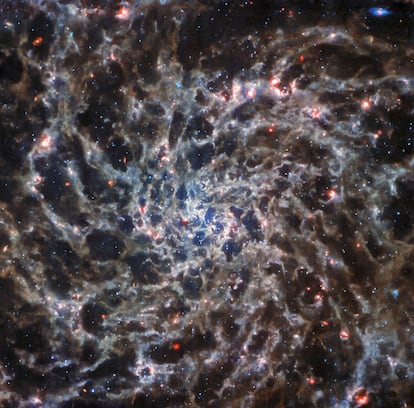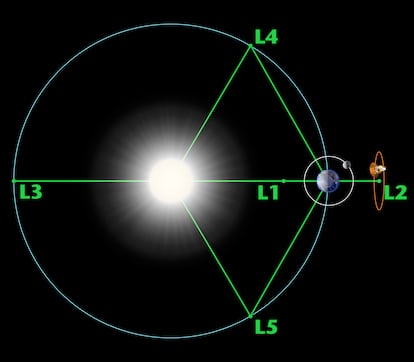The orbit of the James Webb telescope and the three-body problem
The resolution and sensitivity of the images sent by the space probe require it to be protected from radiation and always oriented towards the Sun, the Earth and the Moon

The James Webb Space Telescope, the largest and most powerful of its kind in history, offers images of unprecedented resolution and sensitivity since its launch at the end of 2021. Its observation instruments operate in the infrared spectrum and need temperatures of -364 degrees Fahrenheit or colder in order to operate correctly. This means they must be protected from both the direct radiation from the Sun and from that reflected by the Earth and the Moon, for which the telescope is equipped with a large sunshield.
To be effective, the James Webb must follow an orbit in which, at any given point, the Sun, Earth and Moon are all in the same direction, which the sunshield will face. This orbit cannot be around the Earth, like that of the Hubble telescope. Instead, a more sophisticated alternative had to be designed, with the help of dynamical systems theory.
The L2 point of the Earth-Sun system fulfills these criteria. This point is 1.5 million kilometers away from Earth – about four times the distance between Earth and the Moon – in the opposite direction to the Sun. Its location derives from the work of 18th-century mathematicians Leonhard Euler and Joseph-Louis Lagrange on the three-body problem. They studied a system of two masses moving in circular orbits around their mass center, and a third, very small mass (an asteroid or artificial satellite) that moves under the gravitational attraction of the first two.
Euler and Lagrange proved that there are five positions of equilibrium for the third mass: three of them (L1, L2 and L3) remain on the line that links the masses, while the other two (L4 and L5) form an equilateral triangle with them. In addition, since the five positions move together with the two masses, the configuration doesn’t change. Therefore, if the masses are the Earth and the Sun and a satellite is placed at point L2, it will move around the Sun accompanying the Earth, staying on the line that joins the Sun and the Earth, as the picture shows.

The L2 orbit has an important characteristic: it is unstable. This means that, over time, any object in it will alter its course and leave. Near the L2 there are other, less unstable orbits, which also meet the requirements of the mission and, in addition, allow the telescope to avoid the shadow of the Earth and the Moon. This is an extra advantage as the James Webb works with electric power obtained through solar panels. They are known as Halo orbits and revolve around the L2, accompanying it on its journey around the Sun. One of them was chosen for the telescope. As it is unstable, trajectory correction maneuvers are required to keep the James Webb in orbit.
An advantage of this instability is that we know that there is a (reduced) number of transfer paths which approximate it. By placing the James Webb on one of these trajectories, it will get closer to the Halo orbit as time progresses. The combination of all these transfer paths forms what is known in mathematics as a differentiable manifold.
The calculation carried out by computer-implemented algorithms shows that a part of it is close to Earth; perfect to send the James Webb to its destination. Thus, the Ariane 5 rocket used in the launch from Kourou, French Guiana, did not leave the telescope in orbit around the Earth – as would be usual – but propelled it to this nearby transfer path. Until reaching the final Halo orbit, the trip was very fast at first, taking about three days to pass the orbit of the Moon, and slower as it got closer to its destination, which was reached after about 30 days from launch.
Ángel Jorba is Professor of Applied Mathematics at the University of Barcelona.
Tu suscripción se está usando en otro dispositivo
¿Quieres añadir otro usuario a tu suscripción?
Si continúas leyendo en este dispositivo, no se podrá leer en el otro.
FlechaTu suscripción se está usando en otro dispositivo y solo puedes acceder a EL PAÍS desde un dispositivo a la vez.
Si quieres compartir tu cuenta, cambia tu suscripción a la modalidad Premium, así podrás añadir otro usuario. Cada uno accederá con su propia cuenta de email, lo que os permitirá personalizar vuestra experiencia en EL PAÍS.
¿Tienes una suscripción de empresa? Accede aquí para contratar más cuentas.
En el caso de no saber quién está usando tu cuenta, te recomendamos cambiar tu contraseña aquí.
Si decides continuar compartiendo tu cuenta, este mensaje se mostrará en tu dispositivo y en el de la otra persona que está usando tu cuenta de forma indefinida, afectando a tu experiencia de lectura. Puedes consultar aquí los términos y condiciones de la suscripción digital.
More information
Últimas noticias
NASA discovers Titan doesn’t have an ocean, but a ‘slushy ice layer’ that increases possibility of life
Innocence lost in the forest of the child soldiers: ‘Each leader of the armed group had his girls’
‘Fallout’ or how the world’s largest company turned an anti-capitalist apocalyptic Western into a phenomenon
From inflation to defending migrants: Eileen Higgins and Zohran Mamdani inaugurate the new Democratic resistance against Trump
Most viewed
- ‘El Limones’ and the growing union disguise of Mexican organized crime
- Christian Louboutin: ‘Young people don’t want to be like their parents. And if their parents wear sneakers, they’re going to look for something else’
- The low-cost creative revolution: How technology is making art accessible to everyone
- ‘We are dying’: Cuba sinks into a health crisis amid medicine shortages and misdiagnosis
- A mountaineer, accused of manslaughter for the death of his partner during a climb: He silenced his phone and refused a helicopter rescue










































